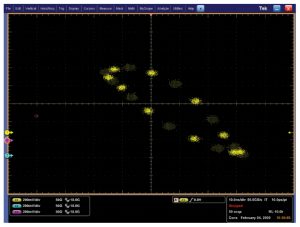

Most consumer products include electronic circuits or components, and an oscilloscope is used throughout the product design process to test those components. But what is an oscilloscope? And what does an oscilloscope measure?
An oscilloscope, formerly known as an oscillograph (informally scope, oscope, or o-scope), is an instrument that graphically displays electrical signals and shows how those signals change over time. Engineers use oscilloscopes to measure electrical phenomena and quickly test, verify, and debug their circuit designs. The primary function of an oscope is to measure voltage waves. Those waves are displayed on a graph that can tell you many things about a signal, such as:
- The time and voltage values of a signal.
- The frequency of an oscillating signal.
- The "moving parts" of a circuit represented by the signal.
- The frequency with which a particular portion of the signal occurs relative to other portions.
- Whether or not a malfunctioning component is distorting the signal.
- How much of a signal is direct current (DC) or alternating current (AC).
- How much of the signal is noise and whether the noise is changing with time.
At a very basic level, the graph displayed on an oscilloscope shows how the signal changes over time with voltage displayed vertically on the Y axis and time represented horizontally on the X axis.

The intensity or brightness of the signal on the scope’s display is sometimes called the Z-axis. On Digital Phosphor Oscilloscopes (DPO), the Z-axis can be represented by color grading of the display.

For more information about reconstructing signals, signal integrity, and waveform measurements, read about the oscilloscopes basics.
What does an oscilloscope measure?
While oscilloscopes are primarily designed to measure volts, they can detect and measure a variety of other signals, including:
Current

Sound

Capacitance

DC Voltage

Frequency

Inductance

Find the right oscilloscope for your application
Not all oscilloscopes are created equal. So, before deciding which machine to invest in, it’s important to understand your project requirements and the type of oscilloscope you might need to get the most efficient, accurate measurements.
There are a number of things to consider when deciding which oscilloscope to buy, including bandwidth, rise time, sample rate, channel density and compatible probes. Read our breakdown of how to choose an oscilloscope or explore our full line of oscilloscopes to find the right one for your application.


